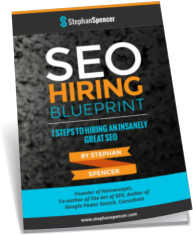Finding the right balance between SEO and a usability can sometimes be a challenge. The two strategies can conflict and companies may mistakenly favor one over the other. For example, one company may choose to stuff the same keywords into every alt tag in their navigation graphics. That, of course, detracts from the user experience, making the page slower to load and making the page difficult to interpret for the visually impaired who rely on screen readers to read web pages to them.
Then there are others who try to maximize usability without any concern for SEO. They choose to “Googleize” their home page, stripping all non-essential elements out of the page and making it as simple and streamlined as Google’s home page. That, unfortunately, offers very little for the search engines to “sink their teeth into,” and consequently insufficient clues for the search engine to identify appropriate keyword themes for your page.
Here’s another way to think of it: search engine spiders are another type of “disabled” visitor — one that can’t read what’s inside your images, fill out your web forms, or interact with the Flash, Java, JavaScript, AJAX etc. on your pages. Therefore, usability and accessibility of your content to spiders is a requirement if you want good search engine rankings. You kill two birds with one stone by optimizing your site’s usability.
In my estimation, usability should come first. An unusable website won’t generate an adequate ROI, even if it ranks well in the engines.
Then there are the sites that miss the mark on both counts — usability and SEO. Consider Nike.com, which just got picked apart for its SEO mistakes in an article on MarketingProfs this week. (I just blogged a quick summary of the article here.) I agree that Nike.com misses the mark in regards to search, and I also find the site severely lacking when it comes to usability and accessibility, IMHO.
I have an article called “Usability and Findability — Getting the Synergy Right” in this month’s issue of Intercom, the magazine of the Society for Technical Communication. If you’re a STC member, you should check it out.

 SIGN UP FOR EXCLUSIVE WEEKLY CONTENT
SIGN UP FOR EXCLUSIVE WEEKLY CONTENT 


Leave a Reply